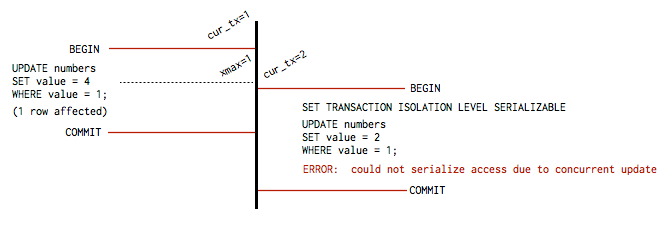PostgreSQL Concurrency with MVCC
来源:互联网 发布:2017金英杰免费网络课 编辑:程序博客网 时间:2024/04/30 16:45
One of the big selling points of Postgres is how it handles concurrency. The promise is simple: reads never block writes and vice versa. Postgres achieves this via a mechanism called Multi Version Concurrency Control. This technique is not unique to Postgres: there are several databases that implement some form of MVCC including Oracle, Berkeley DB, CouchDB and many more. Understanding how MVCC is implemented in Postgres is important when designing highly concurrent apps on PostgreSQL. It’s actually a very elegant and simple solution to a hard problem.
How MVCC works
Every transaction in postgres gets a transaction ID called XID. This includes single one statement transactions such as an insert, update or delete, as well as explicitely wrapping a group of statements together via BEGIN - COMMIT. When a transaction starts, Postgres increments an XID and assigns it to the current transaction. Postgres also stores transaction information on every row in the system, which is used to determine whether a row is visible to the transaction or not.
For example, when you insert a row, postgres will store the XID in the row and call it xmin. Every row that has been committed and has an xmin that is less than the current transaction’s XID is visible to the transaction. This means that you can start a transaction and insert a row, and until that transaction COMMITs that row will not be visible to other transactions. Once it commits and other transactions get created, they will be able to view the new row because they satisfy the xmin < XID condition – and the transaction that created the row has completed.
A similar mechanism occurs for DELETEs and UPDATEs, only in these cases Postgres stores an xmax value on each row in order to determine visibility. This diagram shows two concurrent transactions inserting and reading rows, and how MVCC comes into play in terms of transaction isolation.
For the following charts, assume the following DDL:
CREATE TABLE numbers (value int);

While the xmin and xmax values are hidden from daily operations, you can actually just ask for them and Postgres will happily give them to you:
SELECT *, xmin, xmax FROM numbers;
You can also get the XID for the current transaction pretty easily:
SELECT txid_current();Neat!
I know what you’re thinking though: what about a two transactions updating the same row at the same time? This is where transaction isolation levels come in. Postgres basically supports two models that allow you to control how this situation should be handled. The default, READ COMMITTED, reads the row after the inital transaction has completed and then executes the statement. It basically starts over if the row changed while it was waiting. For instance, if you issue an UPDATE with a WHERE clause, the WHERE clause will rerun after the initial transaction commits, and the UPDATE takes place if the WHERE clause is still satisfied. Here’s an example of two transactions modifying a row where the initial UPDATE causes the WHERE clause of the second transaction to return no rows. Therefore the second transaction does not update any rows at all:

If you need finer control over this behavior, you can set the transaction isolation level to SERIALIZABLE. With this strategy the above scenario will just fail, because it says “If the row I’m modifying has been modified by another transaction, don’t even try,” and Postgres will respond with the error messageERROR: could not serialize access due to concurrent update. It’s up to your app to handle that error and try again, or to give up if that’s what makes sense.

Disadvantages of MVCC
Now that you know how MVCC and transaction isolation actualy works, you’ve added another tool for solving the kinds of problems where a SERIALIZABLEisolation level comes in handy. While the advantages of MVCC are clear it also has some disadvantages.
Because different transactions will have visibility to a different set of rows, Postgres needs to maintain potentially obsolete records. This is why an UPDATEactually creates a new row and why DELETE doesn’t really remove the row: it merely marks it as deleted and sets the XID values appropriately. As transactions complete, there will be rows in the database that cannot possibly be visible to any future transactions. These are called dead rows. Another problem that comes from MVCC is that transaction IDs can only ever grow so much – they are 32 bits and can “only” support around 4 billion transactions. When the XID reaches its max, it will wraparound and start back at zero. Suddenly all rows appear to be in future transactions, and no new transactions would have visibility into those rows.
Both dead rows and the transaction XID wraparound problem are solved withVACUUM. This should be routine maintenance, but thankfuly Postgres comes with an auto_vacuum daemon that will run at a configurable frequency. It’s important to keep an eye on this because different deployments will have different needs when it comes to vacuum frequency. You can read more about what VACUUM actually does on the Postgres docs and how Heroku handles it.
- PostgreSQL Concurrency with MVCC
- MVCC-multi version concurrency control
- mysql Multiversion Concurrency Control机制(mvcc)
- PostgreSQL的MVCC并发处理
- PostgreSQL的MVCC并发处理
- Postgresql MVCC机制源码初探
- Creating Concurrency with Threads
- 转载:PostgreSQL的MVCC并发处理
- postgresql事物隔离级别以及MVCC
- PostgreSQL的MVCC并发处理方式
- MVCC(多版本并发控制,MultiVersion Concurrency Control)
- MVCC(Multi-Version Concurrency Control)多版本并发控制
- 6.16 Creating Concurrency with Threads
- MVCC
- MVCC
- MVCC
- mvcc
- mvcc
- Jump Game II
- IOS XMPP引入时产生错误信息 “libxml/tree.h no such file or directory”
- 《C/C++/Java/Pascal 程序设计基础》习题集 解题1
- ios文件预览以及使用其他应用打开文件
- java获取本机公网IP
- PostgreSQL Concurrency with MVCC
- 说说mysql索引
- 记录 在表中 第几次出现
- 做一个好的项目经理
- HDU 3501 Calculation 2 (欧拉函数)
- Path Sum II
- 各种拟合,一元、多元、对数、指数、单峰、自定义拟合
- hdoj2031十进制转为任意进制
- AFNetworking、MKNetworkKit和ASIHTTPRequest对比


